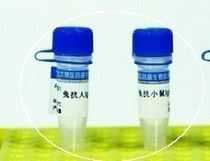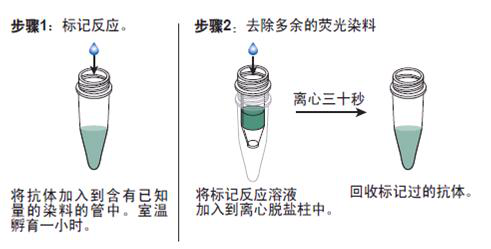
|

| 产地 | 进口、国产 |
| 品牌 | 上海莼试 |
| 保存条件 | Store at -20 °C |
| 货号 | CS9836 |
| 应用范围 | WB=1:100-500 ELISA=1:500-1000 IP=1:20-100 IHC-P=1:100-500 IHC-F=1:100-500 IF=1:100-500 |
| CAS编号 | |
| 抗体名 | Anti-Noggin |
| 克隆性 | |
| 靶点 | 详见说明书 |
| 适应物种 | 详见说明书 |
| 形态 | 详见说明书 |
| 宿主 | 详见说明书 |
| 亚型 | IgG |
| 标识物 | 详见说明书 |
| 浓度 | 1mg/1ml% |
| 免疫原 | KLH conjugated synthetic peptide derived from human Noggin (35-74aa) |
产品订购信息:
英文名称 Anti-Noggin
中文名称 指(趾)关节粘连NOG蛋白抗体说明书
别 名 NOG; NOGG_HUMAN; Noggin; SYM 1; SYM1; Symphalangism 1 (proximal); Synostoses (multiple) syndrome 1; SYNS 1; SYNS1.


浓 度 1mg/1ml
规 格 0.2ml/200μg
抗体来源 Rabbit
克隆类型 polyclonal
交叉反应 Human, Mouse, Rat, Chicken, Dog, Pig, Cow, Horse, Rabbit, Sheep
产品类型 一抗
研究领域 细胞生物 发育生物学 信号转导 干细胞
蛋白分子量 predicted molecular weight: 23kDa
性 状 Lyophilized or Liquid
免 疫 原 KLH conjugated synthetic peptide derived from human Noggin (35-74aa)
亚 型 IgG
纯化方法 affinity purified by Protein A
储 存 液 Preservative: 15mM Sodium Azide, Constituents: 1% BSA, 0.01M PBS, pH 7.4
指(趾)关节粘连NOG蛋白抗体说明书 产品应用 WB=1:100-500 ELISA=1:500-1000 IP=1:20-100 IHC-P=1:100-500 IHC-F=1:100-500 IF=1:100-500
(石蜡切片需做抗原修复)
not yet tested in other applications.
optimal dilutions/concentrations should be determined by the end user.
保存条件 Store at -20 °C for one year. Avoid repeated freeze/thaw cycles. The lyophilized antibody is stable at room temperature for at least one month and for greater than a year when kept at -20°C. When reconstituted in sterile pH 7.4 0.01M PBS or diluent of antibody the antibody is stable for at least two weeks at 2-4 °C.
Important Note This product as supplied is intended for research use only, not for use in human, therapeutic or diagnostic applications.
产品介绍 Noggin is a secreted protein involved at multiple stages of vertebrate embryonic development including neural induction and is known to exert its effects by inhibiting the bone morphogenetic protein (BMP)-signaling pathway. It binds several BMPs with very high (picomolar) affinities, with a marked preference for BMP2 and BMP4 over BMP7. By binding tightly to BMPs, Noggin prevents BMPs from binding their receptors. Noggin binds the bone morphogenetic proteins (BMP) such as BMP-4 and BMP-7, and inhibits BMP signaling by blocking the molecular interfaces of the binding epitopes for both type I and type II receptors. Interaction of BMP and its antagonist Noggin governs various developmental and cellular processes, including embryonic dorsal-ventral axis, induction of neural tissue, formation of joints in the skeletal system and neurogenesis in the adult brain. Noggin plays a key role in neural induction by inhibiting BMP4, along with other TGF-β signaling inhibitors such as chordin and follistatin. Mouse knockout experiments have demonstrated that noggin also plays a crucial role in bone development, joint formation, and neural tube fusion.
Function : Essential for cartilage morphogenesis and joint formation. Inhibitor of bone morphogenetic proteins (BMP) signaling which is required for growth and patterning of the neural tube and somiteSubunit : Homodimer.Subcellular Location : Secreted.DISEASE : Defects in NOG are a cause of symphalangism proximal syndrome (SYM1) [MIM:185800]. SYM1 is characterized by the hereditary absence of the proximal interphalangeal (PIP) joints (Cushing symphalangism). Severity of PIP joint involvement diminishes towards the radial side. Distal interphalangeal joints are less frequently involved and metacarpophalangeal joints are rarely affected whereas carpal bone malformation and fusion are common. In the lower extremities, tarsal bone coalition is common. Conducive hearing loss is seen and is due to fusion of the stapes to the petrous part of the temporal bone.Defects in NOG are the cause of multiple synostoses syndrome type 1 (SYNS1) [MIM:186500]; also known as synostoses, multiple, with brachydactyly/symphalangism-brachydactyly syndrome. SYNS1 is characterized by tubular-shaped (hemicylindrical) nose with lack of alar flare, otosclerotic deafness, and multiple progressive joint fusions commencing in the hand. The joint fusions are progressive, commencing in the fifth proximal interphalangeal joint in early childhood (or at birth in some individuals) and progressing in an ulnar-to-radial and proximal-to-distal direction. With increasing age, ankylosis of other joints, including the cervical vertebrae, hips, and humeroradial joints, develop.Defects in NOG are the cause of tarsal-carpal coalition syndrome (TCC) [MIM:186570]. TCC is an autosomal dominant disorder characterized by fusion of the carpals, tarsals and phalanges, short first metacarpals causing brachydactyly, and humeroradial fusion. TCC is allelic to SYM1, and different mutations in NOG can result in either TCC or SYM1 in different families.Defects in NOG are a cause of stapes ankylosis with broad thumb and toes (SABTS) [MIM:184460]; also known as Teunissen-Cremers syndrome. SABTS is a congenital autosomal dominant disorder that includes hyperopia, a hemicylindrical nose, broad thumbs, great toes, and other minor skeletal anomalies but lacked carpal and tarsal fusion and symphalangism.Defects in NOG are the cause of brachydactyly type B2 (BDB2) [MIM:611377]. BDB2 is a subtype of brachydactyly characterized by hypoplasia/aplasia of distal phalanges in combination with distal symphalangism, fusion of carpal/tarsal bones, and partial cutaneous syndactyly.Similarity : Belongs to the noggin family.Database links : UniProtKB/Swiss-Prot: Q13253.1

Anti-CK20/FITC 荧光素标记细胞角蛋白20抗体IgGMulti-class antibodies规格: 0.2ml
Anti-Phospho-IRF3 (Ser396)/FITC 荧光素标记磷酸化干扰素调节因子3抗体IgGMulti-class antibodies规格: 0.2ml
Rhesus antibody Rh CCL20/MIP3 alpha 巨噬细胞炎性蛋白MIP-3a抗体 规格 0.1ml
IL-13(Interleukin-13) 白介素13抗原 0.5mg
HSH2D 英文名称: HSH2D抗体 0.1ml
Rhesus antibody Rh SPA-1/SIPA-1 信号感应增殖相关蛋白1抗体 规格 0.1ml
Anti-Phospho-IRF3 (Ser396)/FITC 荧光素标记磷酸化干扰素调节因子3抗体IgGMulti-class antibodies规格: 0.2ml
IL-11 ELISA Kit 大鼠白介素11Multi-class antibodies规格: 48T
Anti-AP2 alpha/FITC 荧光素标记转录激活蛋白2α抗体IgGMulti-class antibodies规格: 0.2ml
Rhesus antibody Rh FAM82A1 微管动力调节蛋白FAM82A抗体 规格 0.2ml
MIS/AMH)ELISA Kit 大鼠缪勒管抑制物质/抗缪勒管激素 96T
Mitochondrial ribosomal protein L11 英文名称: 线粒体核糖体蛋白L11抗体 0.2ml
phospho-arfaptin 2 (Ser260) 英文名称: 磷酸化ADP核糖基化因子结合蛋白2抗体 0.1ml
Anti-AP2 alpha/FITC 荧光素标记转录激活蛋白2α抗体IgGMulti-class antibodies规格: 0.2ml
Anti-Phospho-GSK-3alpha (Ser21) /FITC 荧光素标记兔抗人、大、小鼠等磷酸化葡萄糖合成激酶-3α抗体IgGMulti-class antibodies规格: 0.2ml
Anti-PAFR/FITC 荧光素标记抗血小板活化因子受体抗体IgGMulti-class antibodies规格: 0.2ml
Rhesus antibody Rh Bcl-6/5 原癌基因Bcl-6抗体 规格 0.2ml
Leptin peptide/FITC 荧光素FITC标记瘦素抗原 1mg
GDNF Receptor alpha 2 英文名称: 胶质细胞系源性神经营养因子受体α2抗体 0.1ml
Rhesus antibody Rh RAC1+RAC2 GTP结合蛋白RAC1+RAC2抗体 规格 0.2ml
Anti-PAFR/FITC 荧光素标记抗血小板活化因子受体抗体IgGMulti-class antibodies规格: 0.2ml
DTMAgar
Elek氏培养基 250(g) incubation media Elek氏培养基 250(g)
萋-尼氏染色液 Ziehl-Neelsen Strain 10毫升×3支 细菌耐酸染色液
匹克氏肉汤基础B250用于一次性使用卫生用品中溶血性链球菌的检验incubationmedia匹克氏肉汤基础B250用于一次性使用卫生用品中溶血性链球菌的检验
GramStaining
亚碲酸血琼脂基础250g用于白喉杆菌的分离培养
列文EMB 琼脂/伊红亚甲蓝乳糖琼脂 incubation media 列文EMB 琼脂/伊红亚甲蓝乳糖琼脂
60g/L氯蛋白胨水(PW) 250g 用于副溶血性弧菌增菌培养。(SN 0173-92)
大鼠神经干细胞成星形胶质细胞诱导分化培养基Ratneuralstemcellsintoastrocytesinduceddifferentiationmedium
BrothMedium
指(趾)关节粘连NOG蛋白抗体说明书 营养肉汤(普通肉汤培养基) 规格: 250g 用途: 用于一般细菌培养、复壮、增菌等,也可用于消毒剂定性消毒效果测定
麦芽汁培养基 规格: 250g 用途: 用于酵母菌的增菌培养
麦芽汁琼脂培养基 规格: 250g 用途: 供酵母菌的培养、鉴定及保存菌种用。
1%聚山梨酯80-玉米琼脂培养基 规格: 100g 用途: 用于白色念珠菌芽管试验的培养

抗体的生物素化标记实验要点:
1. 指(趾)关节粘连NOG蛋白抗体说明书 如在反应混合液中有叠氮钠或游离氨基存在,会抑制标记反应。因此,蛋白质在反应前要对 0.1mol/L碳酸氢钠缓冲液或0.5mol/L硼酸缓冲液充分透析;
2.所用的NHSB及待生物素化蛋白质之间的分子比按蛋白质表面的ε-氨基的密度会有所不同,选择不当则影响标记的效率,应先用几个不同的分子比来筛选最适条件;
3.用NHSB量过量也是不利的,抗原的结合位点可能因此被封闭,导致抗体失活;
4.由于抗体的氨基不易接近可能造成生物素化不足,此时可加入去污剂如 Triton x-100, Tween20等;
5.当游离ε-氨基(赖氨酸残基的氨基)存在于抗体的抗原结合位点时,或位于酶的催化位点时,生物素化会降低或损伤抗体蛋白的结合力或活性;
6.生物素还可能与不同的功能基团,如羰基、氨基、巯基、异咪唑基及*基,也可与糖基共价结合;
7.交联反应后,应充分透析,否则,残余的生物素会对生物素化抗体与亲和素的结合产生竞争作用;
8.在细胞的荧光标记实验中,中和亲和素的本底低,但由于链霉亲和素含有少量正电荷,故对某些细胞可导致高本底。
抗体的鉴定:
1)指(趾)关节粘连NOG蛋白抗体说明书 抗体的效价鉴定:不管是用于诊断还是用于,制备抗体的目的都是要求较高效价。不同的抗原制备的抗体,要求的效价不一。鉴定效价的方法很多,包括有试管凝集反应,琼脂扩散试验,酶联免疫吸附试验等。常用的抗原所制备的抗体一般都有约成的鉴定效价的方法,以资比较。如制备抗抗体的效价,一般就采用琼脂扩散试验来鉴定。
2)抗体的特异性鉴定:抗体的特异性是指与相应抗原或近似抗原物质的识别能力。抗体的特异性高,它的识别能力就强。衡量特异性通常以交叉反应率来表示。交叉反应率可用竞争抑制试验测定。以不同浓度抗原和近似抗原分别做竞争抑制曲线,计算各自的结合率,求出各自在IC50时的浓度,并按公式计算交叉反应率。
如果所用抗原浓度IC50浓度为pg/管,而一些近似抗原物质的IC50浓度几乎是无穷大时,表示这一抗血清与其他抗原物质的交叉反应率近似为0,即该血清的特异性较好。
3)抗体亲和力:是指抗体和抗原结合的牢固程度。亲和力的高低是由抗原分子的大小,抗体分子的结合位点与抗原决定簇之间立体构型的合适度决定的。有助于维持抗原抗体复合物稳定的分子间力有氢键,疏水键,侧链相反电荷基因的库仑力,范德华力和空间斥力。亲和力常以亲和常数K表示,K的单位是L/mol。抗体亲和力的测定对抗体的筛选,确定抗体的用途,验证抗体的均一性等均有重要意义。